NESTML Ornstein-Uhlenbeck noise tutorial
In this tutorial, we will formulate the Ornstein-Uhlenbeck (O-U) noise process in NESTML and simulate it in NEST Simulator.
[1]:
%matplotlib inline
import matplotlib.pyplot as plt
import nest
import numpy as np
import os
from pynestml.codegeneration.nest_code_generator_utils import NESTCodeGeneratorUtils
The Ornstein-Uhlenbeck process
The Ornstein-Uhlenbeck process is often used as a source of noise because it is well understood and has convenient properties (it is a Gaussian process, has the Markov property, and is stationary). Let the O-U process, denoted \(U(t)\) (with \(t\geq 0\)) , be defined as the solution of the following stochastic differential equation:
\begin{align} \frac{dU}{dt} = \frac{\mu - U}{\tau} + \sigma\sqrt{\frac 2 \tau} \frac{dB(t)}{dt} \end{align}
The first right-hand side term is a “drift” term which is deterministic and slowly reverts \(U_t\) to the mean \(\mu\), with time constant \(\tau\). The second term is stochastic as \(B(t)\) is the Brownian motion (also “Wiener”) process, and \(\sigma>0\) is the standard deviation of the noise.
It turns out that the infinitesimal step in Brownian motion is white noise, that is, an independent and identically distributed sequence of Gaussian \(\mathcal{N}(0, 1)\) random variables. The noise \(dB(t)/dt\) can be sampled at time \(t\) by drawing a sample from that Gaussian distribution, so if the process is sampled at discrete intervals of length \(h\), we can write (equation 2.47 from [1]):
\begin{align} U(t + h) = \mu + (U(t) - \mu)\exp(-h/\tau) + \sigma\sqrt{(1 - \exp(-2h / \tau ))} \cdot\mathcal{N}(0, 1) \end{align}
Simulating the Ornstein-Uhlenbeck process with NESTML
Formulating the model in NESTML
The O-U process is now defined as a stepwise update equation, that is carried out at each timestep. All statements contained in the NESTML update block are run at every timestep, so this is a natural place to place the O-U updates.
Updating the O-U process state requires knowledge about how much time has elapsed. As we will update the process once every simulation timestep, we pass this value by invoking the resolution() function.
[2]:
nestml_ou_model = '''
neuron ornstein_uhlenbeck_noise:
parameters:
mean_noise real = 500 # mean of the noise
sigma_noise real = 50 # std. dev. of the noise
tau_noise ms = 20 ms # time constant of the noise
internals:
A_noise real = sigma_noise * ((1 - exp(-2 * resolution() / tau_noise)))**.5
state:
U real = mean_noise # set the initial condition
update:
U = mean_noise \
+ (U - mean_noise) * exp(-resolution() / tau_noise) \
+ A_noise * random_normal(0, 1)
'''
Save to a temporary file and make the model available to instantiate in NEST:
[3]:
# generate and build code
module_name, neuron_model_name_adapt_curr = \
NESTCodeGeneratorUtils.generate_code_for(nestml_ou_model)
# load dynamic library (NEST extension module) into NEST kernel
nest.Install(module_name)
[6,ornstein_uhlenbeck_noisea0ddeae3e8dd4f9ba89af92d5cee45f1_nestml, WARNING, [2:0;16:0]]: Input block not defined!
[7,ornstein_uhlenbeck_noisea0ddeae3e8dd4f9ba89af92d5cee45f1_nestml, WARNING, [2:0;16:0]]: Output block not defined!
[16,ornstein_uhlenbeck_noisea0ddeae3e8dd4f9ba89af92d5cee45f1_nestml, WARNING, [2:0;16:0]]: Input block not defined!
[17,ornstein_uhlenbeck_noisea0ddeae3e8dd4f9ba89af92d5cee45f1_nestml, WARNING, [2:0;16:0]]: Output block not defined!
Running the simulation in NEST
Let’s define a function that will instantiate and set parameters for the O-U model, run a simulation, and plot and return the results.
[4]:
def evaluate_ou_process(neuron_model_name: str, h: float=.1, t_sim:float=100., neuron_parms=None, title=None, plot=True):
"""
h : float
timestep in ms
t_sim : float
total simulation time in ms
"""
nest.ResetKernel()
nest.SetKernelStatus({"resolution": h})
neuron = nest.Create(neuron_model_name)
if neuron_parms:
for k, v in neuron_parms.items():
nest.SetStatus(neuron, k, v)
multimeter = nest.Create("multimeter")
multimeter.set({"record_from": ["U"],
"interval": h})
nest.Connect(multimeter, neuron)
nest.Simulate(t_sim)
dmm = nest.GetStatus(multimeter)[0]
U = dmm["events"]["U"]
timevec = dmm["events"]["times"]
if plot:
fig, ax = plt.subplots(figsize=(12., 5.))
if title is not None:
fig.suptitle(title)
ax.plot(timevec, U)
ax.set_xlabel("Time [ms]")
ax.set_ylabel("U")
ax.set_xlim(0., t_sim)
ax.grid()
return timevec, U
Then, we can run the process. Hint: play with the parameters a bit here and see the effects it has on the returned timeseries.
[5]:
timevec, U = evaluate_ou_process(neuron_model_name_adapt_curr,
h=1.,
t_sim=1000.,
neuron_parms={"U" : -2500.,
"mean_noise": -3333.,
"tau_noise": 20.,
"sigma_noise": 100.},
title=r"Ornstein-Uhlenbeck process")

Correctness test based on predicting variance
Assuming that the initial value of the process is picked equal to the process mean, we can predict the variance of the timeseries as ([1], eq. 2.26):
\begin{align} \text{Var}(U) = \sigma^2 \end{align}
We now run a consistency check across parameters, to make sure that the prediction matches the result derived from the timeseries generated by sampling the process.
[6]:
h = [.01, .1, 1.]
tau_noise = [10., 100., 1000.]
sigma_noise = [0., 10., 100., 1000.]
max_rel_error = .25 # yes, this is pretty terrible!
# Need a very long integration time (esp. for large tau)
# to get a tighter bound.
for _h in h:
for _tau_noise in tau_noise:
for _sigma_noise in sigma_noise:
print("For h = " + str(_h) + ", tau_noise = " + str(_tau_noise) + ", sigma_noise = " + str(_sigma_noise))
c = (_sigma_noise * np.sqrt(2 / _tau_noise))**2
timevec, U = evaluate_ou_process(neuron_model_name_adapt_curr,
h=_h,
t_sim=25000.,
neuron_parms={"U" : 0.,
"mean_noise": 0.,
"tau_noise": _tau_noise,
"sigma_noise": _sigma_noise},
title=r"Ornstein-Uhlenbeck process ($\tau$=" + str(_tau_noise) + ", $\sigma$=" + str(_sigma_noise) + ")",
plot=False)
var_actual = np.var(U)
print("Actual variance: " + str(var_actual))
var_expected = _sigma_noise**2
print("Expected variance: " + str(var_expected))
if var_actual < 1E-15:
assert var_expected < 1E-15
else:
assert np.abs(var_expected - var_actual) / (var_expected + var_actual) < max_rel_error
For h = 0.01, tau_noise = 10.0, sigma_noise = 0.0
Actual variance: 0.0
Expected variance: 0.0
For h = 0.01, tau_noise = 10.0, sigma_noise = 10.0
Actual variance: 102.20988990712311
Expected variance: 100.0
For h = 0.01, tau_noise = 10.0, sigma_noise = 100.0
Actual variance: 10220.988990712309
Expected variance: 10000.0
For h = 0.01, tau_noise = 10.0, sigma_noise = 1000.0
Actual variance: 1022098.8990712308
Expected variance: 1000000.0
For h = 0.01, tau_noise = 100.0, sigma_noise = 0.0
Actual variance: 0.0
Expected variance: 0.0
For h = 0.01, tau_noise = 100.0, sigma_noise = 10.0
Actual variance: 114.93711386061999
Expected variance: 100.0
For h = 0.01, tau_noise = 100.0, sigma_noise = 100.0
Actual variance: 11493.711386061985
Expected variance: 10000.0
For h = 0.01, tau_noise = 100.0, sigma_noise = 1000.0
Actual variance: 1149371.1386062026
Expected variance: 1000000.0
For h = 0.01, tau_noise = 1000.0, sigma_noise = 0.0
Actual variance: 0.0
Expected variance: 0.0
For h = 0.01, tau_noise = 1000.0, sigma_noise = 10.0
Actual variance: 94.22840893430514
Expected variance: 100.0
For h = 0.01, tau_noise = 1000.0, sigma_noise = 100.0
Actual variance: 9422.840893430452
Expected variance: 10000.0
For h = 0.01, tau_noise = 1000.0, sigma_noise = 1000.0
Actual variance: 942284.0893430448
Expected variance: 1000000.0
For h = 0.1, tau_noise = 10.0, sigma_noise = 0.0
Actual variance: 0.0
Expected variance: 0.0
For h = 0.1, tau_noise = 10.0, sigma_noise = 10.0
Actual variance: 99.45410074367867
Expected variance: 100.0
For h = 0.1, tau_noise = 10.0, sigma_noise = 100.0
Actual variance: 9945.410074367865
Expected variance: 10000.0
For h = 0.1, tau_noise = 10.0, sigma_noise = 1000.0
Actual variance: 994541.0074367868
Expected variance: 1000000.0
For h = 0.1, tau_noise = 100.0, sigma_noise = 0.0
Actual variance: 0.0
Expected variance: 0.0
For h = 0.1, tau_noise = 100.0, sigma_noise = 10.0
Actual variance: 96.9767512879476
Expected variance: 100.0
For h = 0.1, tau_noise = 100.0, sigma_noise = 100.0
Actual variance: 9697.675128794752
Expected variance: 10000.0
For h = 0.1, tau_noise = 100.0, sigma_noise = 1000.0
Actual variance: 969767.5128794758
Expected variance: 1000000.0
For h = 0.1, tau_noise = 1000.0, sigma_noise = 0.0
Actual variance: 0.0
Expected variance: 0.0
For h = 0.1, tau_noise = 1000.0, sigma_noise = 10.0
Actual variance: 137.92761151483887
Expected variance: 100.0
For h = 0.1, tau_noise = 1000.0, sigma_noise = 100.0
Actual variance: 13792.761151483948
Expected variance: 10000.0
For h = 0.1, tau_noise = 1000.0, sigma_noise = 1000.0
Actual variance: 1379276.115148398
Expected variance: 1000000.0
For h = 1.0, tau_noise = 10.0, sigma_noise = 0.0
Actual variance: 0.0
Expected variance: 0.0
For h = 1.0, tau_noise = 10.0, sigma_noise = 10.0
Actual variance: 102.54886144081759
Expected variance: 100.0
For h = 1.0, tau_noise = 10.0, sigma_noise = 100.0
Actual variance: 10254.886144081758
Expected variance: 10000.0
For h = 1.0, tau_noise = 10.0, sigma_noise = 1000.0
Actual variance: 1025488.6144081757
Expected variance: 1000000.0
For h = 1.0, tau_noise = 100.0, sigma_noise = 0.0
Actual variance: 0.0
Expected variance: 0.0
For h = 1.0, tau_noise = 100.0, sigma_noise = 10.0
Actual variance: 102.69332568184711
Expected variance: 100.0
For h = 1.0, tau_noise = 100.0, sigma_noise = 100.0
Actual variance: 10269.332568184713
Expected variance: 10000.0
For h = 1.0, tau_noise = 100.0, sigma_noise = 1000.0
Actual variance: 1026933.2568184711
Expected variance: 1000000.0
For h = 1.0, tau_noise = 1000.0, sigma_noise = 0.0
Actual variance: 0.0
Expected variance: 0.0
For h = 1.0, tau_noise = 1000.0, sigma_noise = 10.0
Actual variance: 65.7477856791866
Expected variance: 100.0
For h = 1.0, tau_noise = 1000.0, sigma_noise = 100.0
Actual variance: 6574.778567918655
Expected variance: 10000.0
For h = 1.0, tau_noise = 1000.0, sigma_noise = 1000.0
Actual variance: 657477.8567918665
Expected variance: 1000000.0
Autocorrelogram
If we plot the autocorrelogram, we should find high correlations only for lags lower than \(\tau\).
Let’s look at a process with \(\tau=1000\):
[7]:
timevec, U = evaluate_ou_process(neuron_model_name_adapt_curr,
h=_h,
t_sim=10000.,
neuron_parms={"U" : 0.,
"mean_noise": 0.,
"tau_noise": 1000.,
"sigma_noise": 1000.},
title=r"Ornstein-Uhlenbeck process ($\tau$=1000, $\sigma$=1000)")
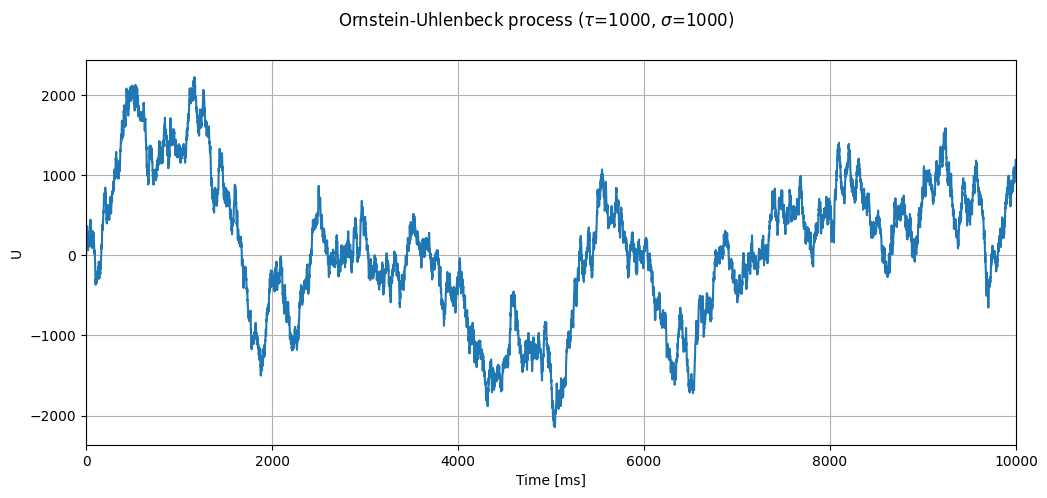
[8]:
def autocorr(x):
return np.correlate(x, x, mode='full')
fig, ax = plt.subplots(figsize=(12., 5.))
U_autocorr = autocorr(U)
lags = np.arange(len(U_autocorr)) - len(U_autocorr) / 2
ax.plot(lags, U_autocorr)
ax.set_xlabel("Lag [ms]")
ax.set_ylabel("Autocorr[U]")
ax.grid()
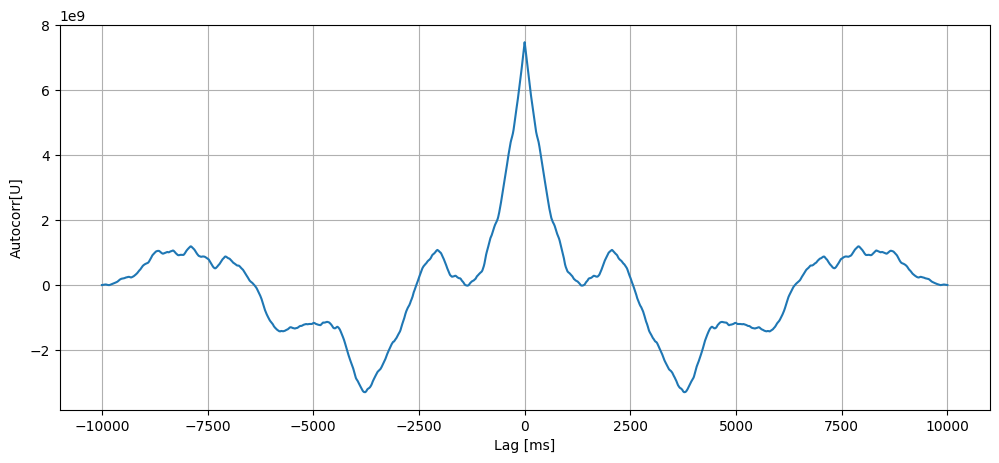
Integrating Ornstein-Uhlenbeck noise into a NESTML integrate-and-fire neuron
Now, the O-U noise process is integrated into an existing NESTML model, as an extra somatic current \(I_{noise}\). In this example, we use the integrate-and-fire neuron with current based synapses and an exponentially shaped synaptic kernel, and no refractoriness mechanism.
This neuron can be written in just a few lines of NESTML:
[9]:
nestml_iaf_psc_exp_model = '''
neuron iaf_psc_exp:
state:
V_m mV = E_L
I_noise pA = mean_noise
equations:
kernel psc_kernel = exp(-t / tau_syn)
V_m' = -(V_m - E_L) / tau_m + (convolve(psc_kernel, spikes) * pA + I_e + I_noise) / C_m
parameters:
E_L mV = -65 mV # resting potential
I_e pA = 0 pA # constant external input current
tau_m ms = 25 ms # membrane time constant
tau_syn ms = 5 ms # synaptic time constant
C_m pF = 250 pF # membrane capacitance
V_theta mV = -30 mV # threshold potential
mean_noise pA = 0.057 pA # mean of the noise current
sigma_noise pA = 0.003 pA # standard deviation of the noise current
tau_noise ms = 10 ms # time constant of the noise process
internals:
A_noise real = sigma_noise * ((1 - exp(-2 * resolution() / tau_noise)))**.5
input:
spikes <- spike
output:
spike
update:
I_noise = mean_noise \
+ (I_noise - mean_noise) * exp(-resolution() / tau_noise) \
+ A_noise * random_normal(0, 1)
integrate_odes()
if V_m > V_theta:
V_m = E_L
emit_spike()
'''
[10]:
# generate and build code
module_name, neuron_model_name = \
NESTCodeGeneratorUtils.generate_code_for(nestml_iaf_psc_exp_model)
# load dynamic library (NEST extension module) into NEST kernel
nest.Install(module_name)
[10,iaf_psc_exp2571d1ed647c4757a4de5a2216df1662_nestml, WARNING, [33:18;33:103]]: Implicit casting from (compatible) type 'pA' to 'real'.
WARNING:Under certain conditions, the propagator matrix is singular (contains infinities).
WARNING:List of all conditions that result in a singular propagator:
WARNING: tau_m = tau_syn
Now, the NESTML model is ready to be used in a simulation.
[11]:
def evaluate_neuron(neuron_name, neuron_parms=None, I_e=0.,
mu=0., sigma=0., t_sim=300., plot=True):
"""
Run a simulation in NEST for the specified neuron. Inject a stepwise
current and plot the membrane potential dynamics and spikes generated.
"""
dt = .1 # [ms]
nest.ResetKernel()
try:
nest.Install("nestml_iaf_module")
except :
pass
neuron = nest.Create(neuron_name)
if neuron_parms:
for k, v in neuron_parms.items():
nest.SetStatus(neuron, k, v)
nest.SetStatus(neuron, "I_e", I_e)
nest.SetStatus(neuron, "mean_noise", mu)
nest.SetStatus(neuron, "sigma_noise", sigma)
multimeter = nest.Create("multimeter")
multimeter.set({"record_from": ["V_m"],
"interval": dt})
sr = nest.Create("spike_recorder")
nest.Connect(multimeter, neuron)
nest.Connect(neuron, sr)
nest.Simulate(t_sim)
dmm = nest.GetStatus(multimeter)[0]
Voltages = dmm["events"]["V_m"]
tv = dmm["events"]["times"]
dSD = nest.GetStatus(sr, keys='events')[0]
spikes = dSD['senders']
ts = dSD["times"]
_idx = [np.argmin((tv - spike_time)**2) - 1 for spike_time in ts]
V_m_at_spike_times = Voltages[_idx]
if plot:
fig, ax = plt.subplots()
ax.plot(tv, Voltages)
ax.scatter(ts, V_m_at_spike_times)
ax.set_xlabel("Time [ms]")
ax.set_ylabel("V_m [mV]")
ax.grid()
return ts
If we stimulate the neuron with a constant current of 300 pA alone, it does not spike:
[12]:
spike_times = evaluate_neuron(neuron_model_name, mu=300, sigma=0.)
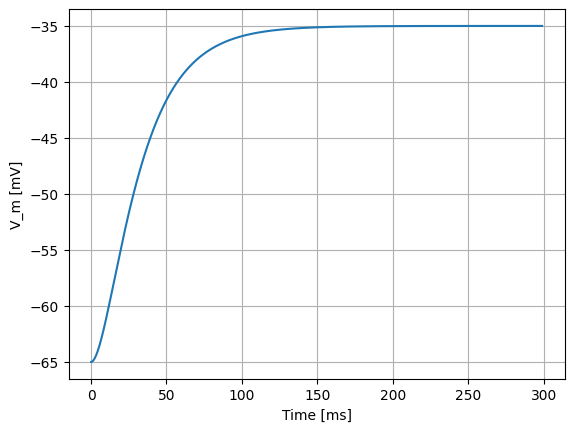
However, for the same \(\mu\)=300 pA, but setting \(\sigma\)=200 pA/√ms, the effect of the noise can be clearly seen in the membrane potential, and the occasional spiking of the neuron:
[13]:
spike_times = evaluate_neuron(neuron_model_name, mu=300, sigma=200)
assert spike_times.size > 0
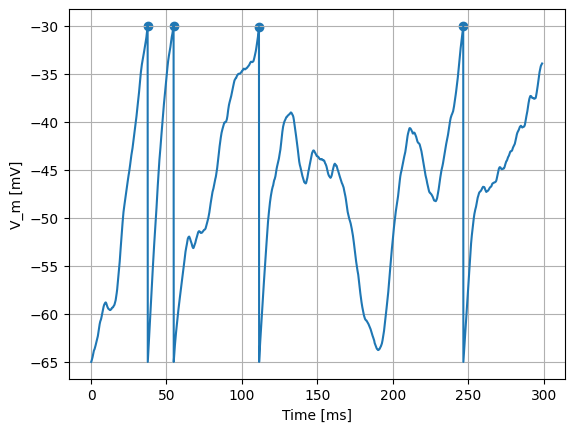
To further quantify the effects of the noise, we can plot a distribution of interspike intervals:
[14]:
spike_times = evaluate_neuron(neuron_model_name,
mu=300,
sigma=200,
t_sim=25000.,
plot=False)
ISI = np.diff(spike_times)
assert ISI.size > 0
ISI_mean = np.mean(ISI)
ISI_std = np.std(ISI)
print(str(len(spike_times)) + " spikes recorded")
print("Mean ISI: " + str(ISI_mean))
print("ISI std. dev.: " + str(ISI_std))
count, bin_edges = np.histogram(ISI)
fig, ax = plt.subplots()
ax.bar(bin_edges[:-1], count, width=.8 * (bin_edges[1] - bin_edges[0]))
ylim = ax.get_ylim()
ax.plot([ISI_mean, ISI_mean], ax.get_ylim(), c="#11CC22", linewidth=3)
ax.plot([ISI_mean - ISI_std, ISI_mean - ISI_std], ylim, c="#CCCC11", linewidth=3)
ax.plot([ISI_mean + ISI_std, ISI_mean + ISI_std], ylim, c="#CCCC11", linewidth=3)
ax.set_ylim(ylim)
ax.set_xlabel("ISI [ms]")
ax.set_ylabel("Count")
ax.grid()
265 spikes recorded
Mean ISI: 94.38257575757575
ISI std. dev.: 88.84117979123644
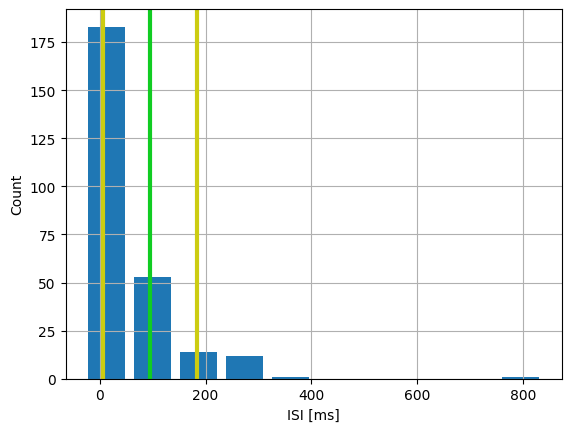
Further directions
Calculate and plot the time-varying expected variance of the OU process when its initial value is unequal to the process mean ([1], eq. 2.26; see Fig. 2 for a visual example)
Make an extension of the neuron model, that stimulates the cell with an inhibitory as well as excitatory noise current.
Instead of a current-based noise, make a neuron model that contains a conductance-based noise.
References
[1] D.T. Gillespie, “The mathematics of Brownian motion and Johnson noise”, Am. J. Phys. 64, 225 (1996); doi: 10.1119/1.18210
Acknowledgements
Thanks to Tobias Schulte to Brinke, Barna Zajzon, Renato Duarte, Claudia Bachmann and all participants of the CNS2020 tutorial on NEST Desktop & NESTML!
This software was developed in part or in whole in the Human Brain Project, funded from the European Union’s Horizon 2020 Framework Programme for Research and Innovation under Specific Grant Agreements No. 720270 and No. 785907 (Human Brain Project SGA1 and SGA2).
License
This notebook (and associated files) is free software: you can redistribute it and/or modify it under the terms of the GNU General Public License as published by the Free Software Foundation, either version 2 of the License, or (at your option) any later version.
This notebook (and associated files) is distributed in the hope that it will be useful, but WITHOUT ANY WARRANTY; without even the implied warranty of MERCHANTABILITY or FITNESS FOR A PARTICULAR PURPOSE. See the GNU General Public License for more details.